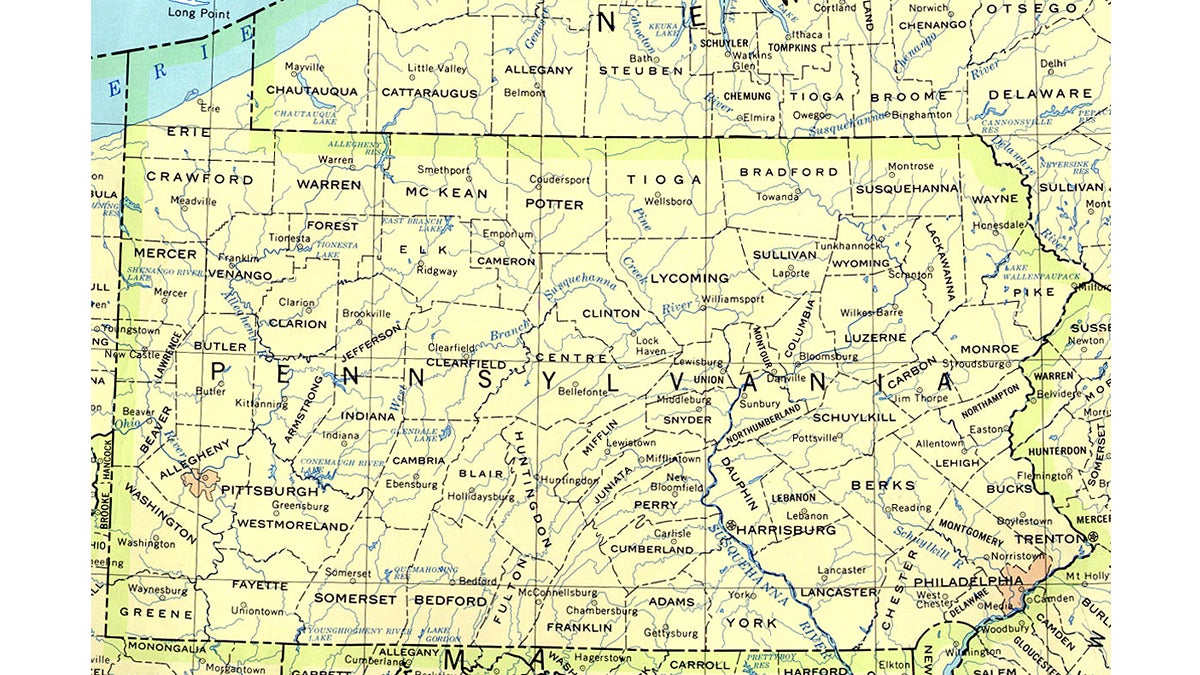Why does Pa. have so many local governments?

Map of the state of Pennsylvania showing county boundaries and names, county seats and rivers from the U.S. Geological Survey.
Seeking a better understanding of Pennsylvania’s issues and proposed solutions? Sometimes, complicated jargon and concepts can get in the way. That’s why we started Explainers, a series that tries to lay out key facts, clarify concepts and demystify jargon. Today’s topic: patchwork governments.
—
Pennsylvania has more local governments than any other state except Texas and Illinois. According to the 2012 Census of Governments the Commonwealth has 4,897 active local governments, which includes administrations at the county, municipal, school district, and special district levels. The Metropolitan Power Diffusion Index, a tool that measures how many local governments perform core services and how much money they spend on them, concluded in 2012 that the Pittsburgh metro area was the second most decentralized in the U.S., after Chicago. Philadelphia also made the top ten list of most decentralized urban areas. The patchwork of governments in the Commonwealth grew organically, but it presents challenges in an increasingly globalized and cash-strapped world.
Why does Pa. have so many governments?
The issue of local government was left up to the states under Article X of the U.S. Constitution. Historically, Pennsylvania has been one of the states that made it easy for local units of government to form. While some states were more restrictive, Pennsylvania law made it easy for a denser, more urbanized area to incorporate and become a separate entity. In that way, Pennsylvania’s communities broke up into smaller and smaller units. Today there is no unincorporated land in the Commonwealth that is not served by a local government smaller than a county.
Additionally, Pennsylvania’s geography had a lot to do with this process. Much of the state is crisscrossed with rivers and physically divided by mountains and valleys. Settlements that were closely located as the bird flies could still be separated by difficult terrain or a physical barrier, like a river, and would draw borders to reflect the actual, accessible community.
Localism is cool, but has nothing really changed? Pennsylvania’s current system of local governance was largely in place by 1900. And aside from a bump in 1962 to 6,202 governments, the number of local governments in Pennsylvania has hovered around 5,000 since the Census of Governments started counting, in 1942. But there have been some changes in what kinds of governments those numbers represent.
In the 1930s, the Commonwealth allowed for the creation of authorities. Unlike a local unit of government that’s responsible for a slew of duties, authorities are established to perform a specific service. That could include things like the maintenance of a sewage system or the construction of a new facility, like a school or transportation building. Originally, authorities were established as a way to avoid rules which placed limits on the amount of debt a municipality could incur. They’ve also proven to be useful tools for projects that cross municipal borders. Pennsylvania has 1,756 authorities.
In the 1960s, a series of bills consolidated school district governments. In the first half of the 20th century, Pennsylvania had about 2,500 school districts. Today, there are 500. The aim of the consolidations was to maximize administrative efficiency and introduce more uniformity in classrooms.
What are the consequences of having so many different governments?
The chopping up of communities into small entities probably seemed natural in the climate of 18th century localism. Back then, people wanted a more intimate relationship with their local government and many still do. People interact more with their local governments and rely daily on the services they provide, which include everything from schools to public safety and sewage management. A recent report by the Pew Research Center showed that people view their local governments more than twice as favorably as they do the federal government, and local governments are more popular than state administrations.
For companies figuring out where to locate, the proliferation of local governments with different rules and perks could mean an opportunity to shop around and find one that fits their particular needs.
But there are down sides, too. For example, when those same companies shop around, it makes municipalities compete against each other, which may not benefit the residents and the region as a whole. Competition between municipalities could result in large firms shifting from one location to another without creating jobs or long-term benefits. The competition could extend to federal and state funds and various projects, something that makes it hard for what are ultimately regional allies to work and plan cooperatively.
Additionally, local governments often no longer reflect the boundaries of metropolitan geography and its needs. In Pittsburgh, for instance, 83 distinct municipalities manage the sewer system that serves the greater metro area. That kind of fragmentation could lead to duplication of infrastructure, as well as staffing and services. When other places, like Maine, consolidated its school districts, it made administration more streamlined and freed up funds for actual education.
Finally, small local governments often don’t have much political power and have less experienced officials. In an increasingly complex world, that can mean ineffective governance.
While some see consolidation as a solution, that can be difficult in Pennsylvania. Director of the University of Pittsburgh’s Center for Metropolitan Studies, David Miller, say municipal cooperation is important but consolidation does not necessarily equal efficiency.
Did this article answer all your questions about Pennsylvania’s patchwork of governments? If not, you can reach Irina Zhorov via email at izhorov@wesa.fm or through social media @zhorovir. Have a topic on which you’d like us to do an Explainer? Let us know in the comment section below, or on Twitter @PaCrossroads.
WHYY is your source for fact-based, in-depth journalism and information. As a nonprofit organization, we rely on financial support from readers like you. Please give today.





